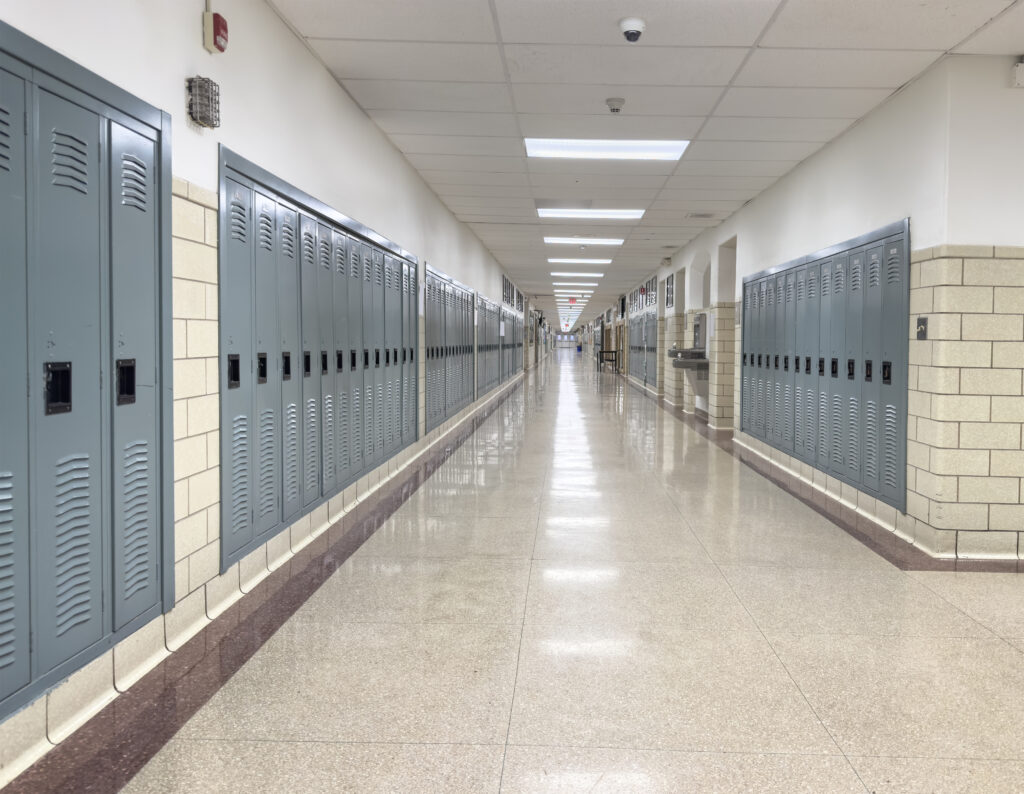October 2025
Sections
- Introduction
- Some Basics
- What’s Different, What’s the Same
- How They Operate
- Growth in the Percentage of SC Public School Students in Charter Schools
- Charter School Performance versus Traditional Public Schools
- About Charter School Authorizers
- Charter School Issues in South Carolina in the News
- Appendix
Introduction
Conversations and debates about “school choice” have become increasingly polarized over the last ten years. The definition of “choice” often includes not only the ability to attend a public school other than the one a student is zoned for (which is common practice in Greenville County Schools), but also to use public funding to support student attendance at other kinds of schools, including homeschools, private schools, or charter schools.
In South Carolina, charter schools are growing rapidly, with mixed outcomes for students. This is in large part because of the way that the state’s charter school system is designed.
Some Basics
Charter schools are public schools: nonprofit and non-religious.
Enacted in South Carolina in 1996 to “create new, innovative, and more flexible ways of educating children within the public school system.”
Open to any student (lottery when space limitations).
Do not charge tuition, receive state and federal funding, and may receive local funds if “chartered” by a traditional school district.
Can be brick-and-mortar or virtual.
What’s Different, What’s the Same
Exempt from many public-school regulations providing flexibility in operations and staffing (e.g. may hire noncertified teachers up to 25% of entire teaching staff).
Still must meet accountability and transparency requirements of traditional public schools (administer the same state assessments and have an annual state report card).
Adhere to the same health, safety, civil rights, and disability rights requirements.
How they Operate
Governed by a board of directors.
May contract out management of the school to a non-profit or for-profit organization.
Overseen by a Charter School Authorizer (sponsor), which gives approval for the school to operate and monitors its management, finances and academic performance (this may be a traditional school district).
To be closed by the authorizer for repeated poor performance or noncompliance with SC charter laws.1
Growth in the Percentage of SC Public School Students in Charter Schools
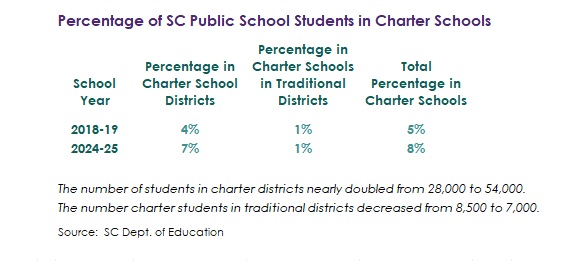
Charter School Performance versus Traditional Public Schools
Nationally, charter schools outperform traditional public schools, but that is not the case in South Carolina.
A 2023 study of national charter school performance found that overall, charter school students gained the equivalent of an additional 16 days of learning in English and an additional 6 days in math compared with similar kids at district schools. The additional days for Black and Hispanic students and students in poverty were even larger. But students with special needs lost days.2
This overall performance was not true for charter schools in South Carolina.
- Reading achievement was not significantly different (students in SC charters lost 8 days of learning per year compared to those in traditional public schools).
- In math, students in SC charters lost 47 days of learning per year compared to traditional public schools or one quarter of a school year.3
- South Carolina was one of 3 states where charter students lost days of learning in both reading and math.4
About Charter School Authorizers
By state law, there are three types of charter school authorizers:
- Traditional school districts.
- The South Carolina Public Charter School District that was established by the state.
- A charter school district established by a public or independent institution of higher education in the state.5
More on traditional school districts: Charter schools authorized by a traditional school district may include those established by the school district itself for specific purposes as well as those established by independent groups of community members which have chosen the school district as their authorizer.
More on higher ed charter districts: In terms of charter districts established by an institution of higher education in the state, there currently are three, and all are private colleges: Charter Institute at Erskine, Limestone Charter Association (in the process of dismantling with the recent closing of the university) and Voorhees University Charter Institute of Learning (recently established).
Funding for authorizers:
- Traditional school districts do not receive additional funding for their oversight of charter schools.
- Charter school districts (the one established by the state and higher ed districts) receive 2% of the general-use state funds received by the charter schools.6
Charter School Issues in South Carolina in the News
Higher Ed institutions became authorizers to help with school financial difficulties.
“As [one college’s} closure reminds us, that provision [in the state law] creates a…profit-making center for colleges that are financially unstable.”
“[one college] was on probation with its accreditor…because of its own financial problems.”7
Charter schools “authorizer shop.” Closed down by one authorizer they move to another.
“…the schools repeatedly avoided a shutdown by moving to new school districts when they were threatened with sanctions.”
“Charter school experts call these attempts to avoid accountability authorizer shopping, meaning the schools “shop” for a district they believe will ignore bad practices or poor academic records.”8
Some charter school authorizers have links to charter management organizations raising concerns of conflicts of interest.
“…like the first two — this college has close ties with a charter management company.”9
State funding of charter schools versus traditional public schools.
During the FY26 budget debate, a budget amendment gave “[charter] virtual schools a smaller share of state public-school money than originally contemplated…leaving more of the state’s finite pot of money to distribute among traditional public schools.”10
“Their effort was intended as a temporary patch…budget negotiators [directed] the state to study those weightings and how to better align them with student enrollment, with a report due in December.”11
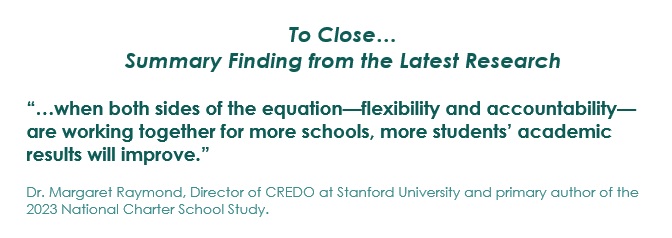
Notes
1“South Carolina Charter Schools Act of 1996” Amended. SC Code of Laws, Section 59-40.
2Raymond, M. E., Woodworth, J. L., Lee, W. F., & Bachofer, S. (2023). As a Matter of Fact: The National Charter School Study III 2023. Center for Research on Education Outcomes (CREDO), Stanford University.
3Center for Research on Education Outcomes (CREDO) (2023), Multi-State Report: “Charter School Versus Public School Academic Growth,” Stanford University.
4Center for Research on Education Outcomes (CREDO) (2023), “CSP31 Technical Appendix.” Stanford University.
5Charter Schools Act Amended.
6Ibid.
7Editorial Staff, The Post and Courier. (2025) “Editorial: With Limestone’s demise, take back control over SC charter schools.”
8Flynn, H., Turcotte, M. and Sheingold, D. (2024) “Some SC charter districts get millions to keep struggling schools afloat,” The Post and Courier.
9Editorial Staff, The Post and Courier. (2024) “Editorial: Third SC charter school authorizer increases odds for profiteering, failure.”
10Grenier, I. and Mitchell, A. B. (2025) “With public school districts hungry for cash, some SC legislators look to cut virtual charter funding,” The Post and Courier.
11Mitchell, A. B. and Grenier, I. (2025) “Lawmakers strike compromise in tug-of-war over distribution of SC public school money,” The Post and Courier.
Appendix
- Number of Charter Schools in SC by Type of Authorizer & Total, 2018-19 and 2024-25.
- Percentage of Students in SC Charter Schools by Type of Authorizer & Total, 2018-19 and 2024-25.
- Student Demographics, Charter Districts versus All Students in Traditional Districts, 2024-25.
- Current State Law on Charters: Section on Responsibilities of Charter Authorizers (Sponsors).
- Proposed Revision to State Law Currently in the Senate.
- Charter Schools in SC by Individual Charter Authorizer, 2018-19 and 2024-25.
- New Orleans Experience with Charter Schools: Some Quick Findings from Latest Research.
1. Number of Charter Schools in SC by Type of Authorizer & Total, 2018-19 and 2024-25
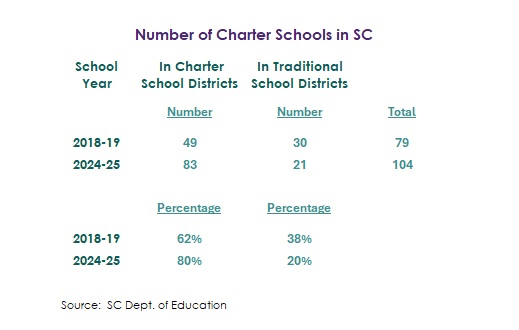
2. Percentage of Students in SC Charter Schools by Type of Authorizer & Total, 2018-19 and 2024-25
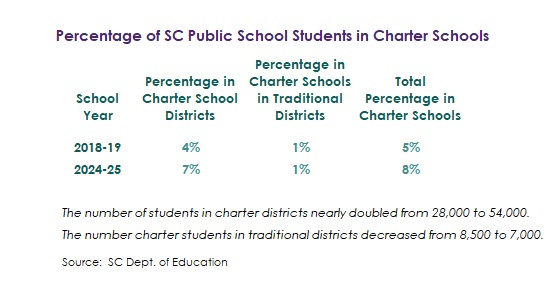
3. Student Demographics, Charter Districts versus All Students in Traditional Districts, 2024-25
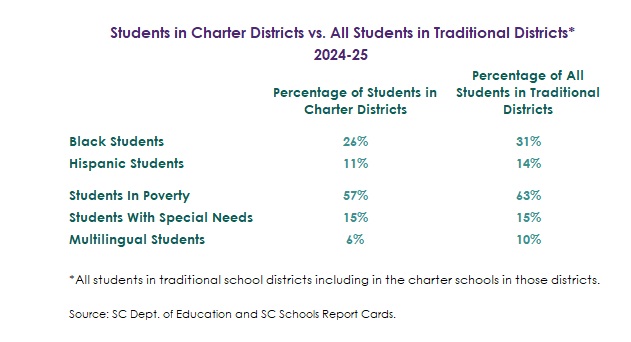
4. Current State Law on Charters: Section on Responsibilities of Charter Authorizers (Sponsors)
SC Code of Laws, Section 59-40-55. Sponsor powers and duties; retention of funds.
(A) In order to promote the quality of charter school outcomes and oversight, the charter school sponsor shall adopt national industry standards of quality charter schools and shall authorize and implement practices consistent with those standards.
(B) A charter school sponsor shall:
(1) approve charter applications that meet the requirements specified in Sections 59-40-50 and 59-40-60;
(2) decline to approve charter applications according to Section 59-40-70(C);
(3) negotiate and execute sound charter contracts with each approved charter school;
(4) monitor, in accordance with charter contract terms, the performance and legal/fiscal compliance of charter schools to include collecting and analyzing data to support ongoing evaluation according to the charter contract;
(5) conduct or require oversight activities that enable the sponsor to fulfill its responsibilities outlined in this chapter, including conducting appropriate inquiries and investigations, only if those activities are consistent with the intent of this chapter, adhere to the terms of the charter contact, and do not unduly inhibit the autonomy granted to public charter schools;
(6) collect, in accordance with Section 59 40 140(H), an annual report from each of its sponsored charter schools and submit the reports to the Department of Education;
(7) notify the charter school of perceived problems if its performance or legal compliance appears to be unsatisfactory and provide reasonable opportunity for the school to remedy the problem, unless the problem warrants revocation and revocation timeframes apply;
(8) take appropriate corrective actions or exercise sanctions short of revocation in response to apparent deficiencies in charter school performance or legal compliance. These actions or sanctions may include requiring a school to develop and execute a corrective action plan within a specified timeframe;
(9) determine whether each charter contract merits renewal, nonrenewal, or revocation;
(10) provide to parents and the general public information about charter schools authorized by the sponsor as an enrollment option within the district in which the charter school is located to the same extent and through the same means as the district in which the charter school is located provides and publicizes information about all public schools in the district. A charter school shall notify its sponsor of its enrollment procedures and dates of its enrollment period no less than sixty days before the first day of its enrollment period; and
(11) permanently close any charter school at the conclusion of the school year after receiving the lowest performance level rating as defined by the federal accountability system for three consecutive years in accordance with Section 59 40 110(E).
(C) The South Carolina Public Charter School District may retain no more than two percent of the total state appropriations for each charter school it authorizes to cover the costs for overseeing its charter schools. The sponsor’s administrative fee does not include costs incurred in delivering services that a charter school may purchase at its discretion from the sponsor. The sponsor’s fee is not applicable to federal money or grants received by the charter school. The sponsor shall use its funding provided pursuant to this section exclusively for the purpose of fulfilling sponsor obligations in accordance with this chapter.
5. Proposed Revision to State Law Currently in the Senate.
S. 454
Summary: Charter School Accountability
Sponsors: Senator Hembree
Introduced in the Senate on March 13, 2025
Last Amended on May 1, 2025
Currently residing in the Senate.
6. Charter Schools in SC by Individual Charter Authorizer, 2018-19 and 2024-25
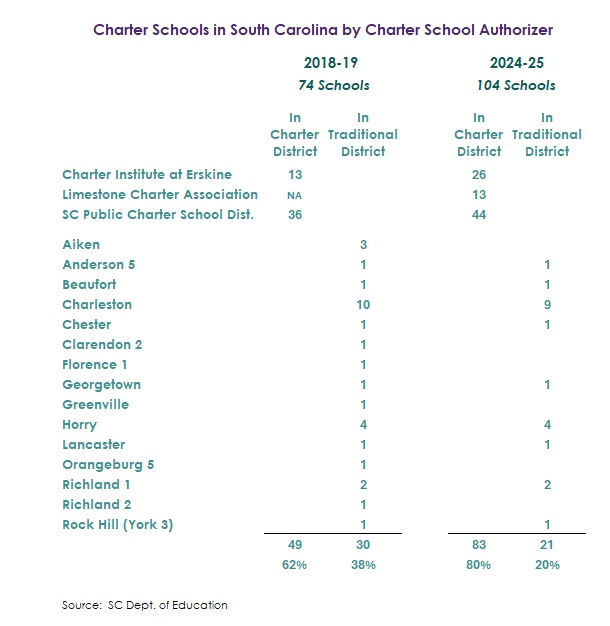
7. New Orleans Experience with Charter Schools: Some Quick Findings from Latest Research
From the report ““The New Orleans Post-Katrina School Reforms: 20 Years of Lessons” from the Education Research Alliance for New Orleans, 2025, and related articles.
Changeover to an All-Charter-School District
- Prior to Katrina, “The district’s students were among the lowest achievers in Louisiana, one of the nation’s lowest-performing states. Only 56 percent of the district’s students earned high school diplomas — 10 percentage points below the state average.”
- After Katrina, control of most New Orleans public schools was handed over to a Recovery School District that the state had created two years before Katrina to turn around low-performing schools throughout Louisiana. (Robelen)
- “By the end of the state takeover 13 years later, all of the city’s publicly funded schools were converted to charter schools.” (Carroll)
- During this time, of the city’s roughly 75 charter schools, the recovery district closed or reconstituted with new leadership at least 50 of these schools. (Robelen)
- New Orleans schools are now reunified into one district governed by the local school board. (Carroll)
Large Gains in Student Achievement
- “The New Orleans reforms led to large gains in average student achievement and increased rates of high school graduation, college entry, and college graduation in the first decade after they were implemented.”
- “Since then, student outcomes have stabilized.”
- “New Orleans schools ranked at the bottom of the state when Katrina hit but have moved up to the middle on most outcomes.” (Harris)
Primary Factor in Achievement Gains
- “The results are not driven by changes in the student population and demographics.”
- “The main mechanism that led to improvements in outcomes for students in New Orleans was the replacement of low-performing schools with higher performing ones.”
- This can improve students’ test scores and outcomes “if these students’ families have the information necessary to select a higher-performing school and they receive priority in the enrollment system to secure a seat.”
Achievement Among Subgroups of Students in New Orleans Schools
- Black students perform at similar rates as Black students across the state.
- White students outperform White students in schools across the state.
- Economically disadvantaged students in New Orleans schools on average have lower test scores than those in schools across the state.
School Environment for Black Students
Black students, which comprise 70% of the student population, report worse school environments than White students in New Orleans schools. They do not feel as supported in schools as their White counterparts. They also report more bullying, less safety, and more inequitable treatment compared to White students. (Carroll)
The Teacher Workforce
- The level of teacher credentials declined.
- Teacher turnover and the share of teachers with low levels of experience increased.
- Despite recent improvements, New Orleans students still rate their teachers worse compared to students across the country.
Other
“The reforms had some other consequences, including a reduced focus on the arts and decreased access to early childhood education….New Orleans still lags behind the rest of the state in pre-K availability.” (Harris)
Sources
Carroll, J.M. and Harris, D.N. (2025) “Creating and sustaining a new kind of education system after Hurricane Katrina in New Orleans,” Brookings Institution.
Harris, D.N. and Carroll, J.M. (2025) The New Orleans Post-Katrina School Reforms: 20 Years of Lessons, Education Research Alliance for New Orleans, Tulane University.
Hill, P. (2025) “Reflections on Rebuilding New Orleans’ Education System, One School at a Time,” Center for Reinventing Public Education, Arizona State University.
Robelen, E. W. and Toch, T. (2025) “Lessons From New Orleans’ Experience as a Charter School Laboratory,” Governing.
20251007

